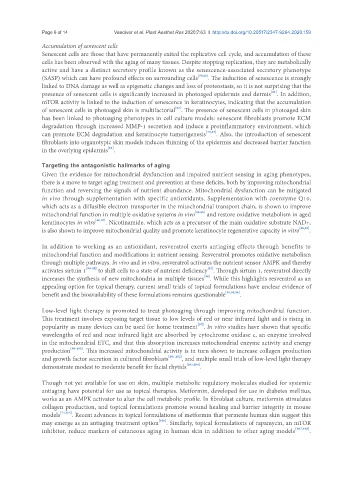Page 742 - Read Online
P. 742
Page 6 of 14 Vandiver et al. Plast Aesthet Res 2020;7:63 I http://dx.doi.org/10.20517/2347-9264.2020.159
Accumulation of senescent cells
Senescent cells are those that have permanently exited the replicative cell cycle, and accumulation of these
cells has been observed with the aging of many tissues. Despite stopping replication, they are metabolically
active and have a distinct secretory profile known as the senescence-associated secretory phenotype
(SASP) which can have profound effects on surrounding cells [79,80] . The induction of senescence is strongly
linked to DNA damage as well as epigenetic changes and loss of proteostasis, so it is not surprising that the
[81]
presence of senescent cells is significantly increased in photoaged epidermis and dermis . In addition,
mTOR activity is linked to the induction of senescence in keratinocytes, indicating that the accumulation
[82]
of senescent cells in photoaged skin is multifactorial . The presence of senescent cells in photoaged skin
has been linked to photoaging phenotypes in cell culture models: senescent fibroblasts promote ECM
degradation through increased MMP-1 secretion and induce a proinflammatory environment, which
can promote ECM degradation and keratinocyte tumorigenesis [79,83] . Also, the introduction of senescent
fibroblasts into organotypic skin models induces thinning of the epidermis and decreased barrier function
[84]
in the overlying epidermis .
Targeting the antagonistic hallmarks of aging
Given the evidence for mitochondrial dysfunction and impaired nutrient sensing in aging phenotypes,
there is a move to target aging treatment and prevention at these deficits, both by improving mitochondrial
function and reversing the signals of nutrient abundance. Mitochondrial dysfunction can be mitigated
in vivo through supplementation with specific antioxidants. Supplementation with coenzyme Q10,
which acts as a diffusible electron transporter in the mitochondrial transport chain, is shown to improve
mitochondrial function in multiple oxidative systems in vivo [85,86] and restore oxidative metabolism in aged
keratinocytes in vitro [66,87] . Nicotinamide, which acts as a precursor of the main oxidative substrate NAD+,
is also shown to improve mitochondrial quality and promote keratinocyte regenerative capacity in vitro [88,89] .
In addition to working as an antioxidant, resveratrol exerts antiaging effects through benefits to
mitochondrial function and modifications in nutrient sensing. Resveratrol promotes oxidative metabolism
through multiple pathways. In vivo and in vitro, resveratrol activates the nutrient sensor AMPK and thereby
[93]
activates sirtuin 1 [90-92] to shift cells to a state of nutrient deficiency . Through sirtuin 1, resveratrol directly
[94]
increases the synthesis of new mitochondria in multiple tissues . While this highlights resveratrol as an
appealing option for topical therapy, current small trials of topical formulations have unclear evidence of
benefit and the bioavailability of these formulations remains questionable [50,95,96] .
Low-level light therapy is promoted to treat photoaging through improving mitochondrial function.
This treatment involves exposing target tissue to low levels of red or near infrared light and is rising in
[97]
popularity as many devices can be used for home treatment . In vitro studies have shown that specific
wavelengths of red and near infrared light are absorbed by cytochrome oxidase c, an enzyme involved
in the mitochondrial ETC, and that this absorption increases mitochondrial enzyme activity and energy
production [98-100] . This increased mitochondrial activity is in turn shown to increase collagen production
and growth factor secretion in cultured fibroblasts [101,102] , and multiple small trials of low-level light therapy
demonstrate modest to moderate benefit for facial rhytids [103,104] .
Though not yet available for use on skin, multiple metabolic regulatory molecules studied for systemic
antiaging have potential for use as topical therapies. Metformin, developed for use in diabetes mellitus,
works as an AMPK activator to alter the cell metabolic profile. In fibroblast culture, metformin stimulates
collagen production, and topical formulations promote wound healing and barrier integrity in mouse
models [74,105] . Recent advances in topical formulations of metformin that permeate human skin suggest this
may emerge as an antiaging treatment option [106] . Similarly, topical formulations of rapamycin, an mTOR
inhibitor, reduce markers of cutaneous aging in human skin in addition to other aging models [107,108] .

